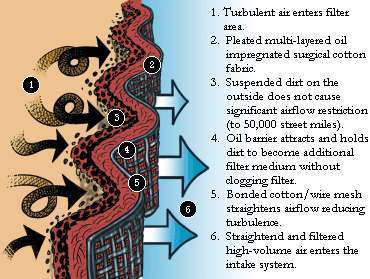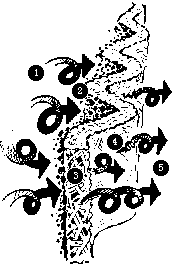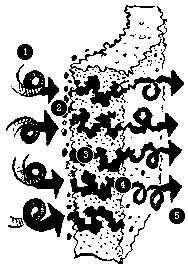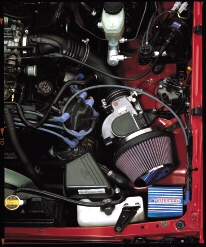
|
|
Facts You Should Know About Air Filters Back to top The primary function of an air filter is to clean the air before it enters the engine. If this is true, why do we see so many engines, especially expensive competition engines, without air filters? The answer is airflow. An engine's power output is proportional to the volume of air it can ingest at any given rpm, assuming the fuel management system is capable of sustaining a near perfect air/fuel mixture ratio. The most minute restriction in the air induction system will cause an engine's optimum power output to drop. Maintaining optimum, unrestricted flow becomes a problem when the air must pass through a filter element. Conventional paper elements are very resistant to air flow because the filter material or medium is very dense. The greater the restriction the greater the power loss. K&N engineers have made vast improvements in performance, durability and serviceability by directly addressing these inherent compromises. In the early '60s, K&N developed an oil impregnated cotton air filter gauze which exceeds the minimum filtration standards while offering little restriction to air flow. As a result, the first K&N filter element was manufactured by sandwiching several layers of surgical gauze between two sheets of wire mesh. The medium was then pleated to reduce the filter's overall size and to increase its surface area. Finally the cotton gauze was oiled to enhance it's filtering capabilities. The original concept exists today and remains the basic component used in all of our automotive, industrial, marine and motorcycle air filters. K&N's oil-impregnated, cotton-gauze element is the basis of our filter, as well as K&N's overall dominance of the reusable air filter market. The process is expensive but well worth the effort. To further make the point, consider that square inch per square inch, our filter will flow an average of 50 percent more air compared to the average paper filter without sacrificing filtration efficiency.
Paper vs K&N Back to top By comparison, paper filters are made from compressed fibers. The spaces between these fibers provide microscopic holes the air must pass through. One by one, these holes become plugged with dirt and dust particles. Once a hole becomes plugged, the air must find an alternate route through the medium. As the filter collects more dirt, its resistance to air flow increases because there are fewer and fewer holes left open and as restriction goes up, horsepower and fuel economy go down. But to meet minimum filtration standards, the paper must be thick and/or the fibers must be tightly compressed and dense. Therefore paper elements that provide adequate filtration are restrictive to air flow by design. Any paper element that could flow as much air as an equivalent K&N would not provide safe filtration. Additionally, as a paper filter becomes more and more clogged, the pressure inside the filter drops while the atmospheric air pressure (approximately 14.6 psig at sea level) outside the filter remains the same. It's like using your lungs to draw the air out of a plastic milk bottle. When the pressure differential becomes too great, the bottle will collapse. The same thing could happen to your paper filter, although it is unlikely. But what will happen could be just as severe. An excessively high pressure differential created by a restricted filter can literally pull dirt particles through the paper medium. In other words, the performance of a paper filter, i.e. air flow through the filter and its ability to protect your engine, DECREASES near the end of its service interval.
The K&N air filter is somewhat more complex. The unique design features an oiled cotton fabric which holds airborne dirt particles. These dirt particles cling to the outside of the filter and actually become part of the filtering media. The cotton fabric is sandwiched between pleated aluminum screen. Pleating increases surface area which in turn promotes air flow and prolongs service intervals. Pleating exposes five times the surface area compared to a flat element like foam. The dirt particles collected on the surface of a K&N element have very little effect on air flow because there are no small holes to clog. Particles are stopped by crisscrossed cotton fibers and held in suspension by the oil. As the filter begins to collect debris, an additional form of filter action begins to take place because air must first pass through the dirt particles trapped on the surface. That means the filtration efficiency of a K&N element actually increase as the filter collects dirt. Tests have shown a K&N E-1500 filter will flow 60 percent of its maximum flow capacity after 50,000 miles of street use. And, considering a new K&N flows half again as much air as a comparable paper element, that same filter will provide all of the air the engine needs even after 50,000 miles. Conversely, dirt trapped by a paper element will impregnate the fibers which will impede air flow at a proportional rate. In other words, performance decreases dramatically as a paper element gets dirty. At the service interval, say 14,000 miles, air flow through a paper element can decrease as much as 70 percent. The efficiency of K&N's oiled cotton gauze medium has been proven time and time again. The condition of the filter can be monitored with a vacuum gauge. The vacuum reading increases as the filter nears its service interval. A high vacuum reading means the filter is dirty and needs to be serviced. Some trucks have logged over 100,000 miles with no loss in air flow as reported by the service technicians. Again this is due in part because a clean K&N filter will flow half again as much air as a comparable paper element. A K&N will provide superior filtration without sacrificing air flow for a longer period of time - that's performance with value. Stock Replacement Filters Back to top For the service-minded consumer, utilizing the stock air filtration system is easiest so we manufacture exact replacement air filter elements to fit in place of the factory filter. Dimensions are held to minimum acceptable tolerances to insure a perfect fit inside the stock air box. Molded rubber sealing surfaces, edges and/or end caps combined with our unique pleated cotton gauze medium creates a filter that is so durable we warrant it for ONE MILLION MILES or 10 years. And, K&N original equipment replacement filters are emissions legal in all 50 states. Street engines are exposed to the same risks as racing engines but for a longer period of time. In this application, a permanent, high performance air filtration system must be durable enough to last the lifetime of the vehicle as it travels through any and all driving conditions. Getting back to air flow for a moment, we have discussed stock air filtration systems and why they compromise air flow. We have also explained how K&N's unique design is less restrictive compared to a paper element. Installing a K&N Filtercharger in place of a original equipment or aftermarket paper filter removes the restriction which then allows the engine to inhale all of the air it can physically use. Increasing the amount of air available to the engine promotes performance since oxygen in the air is a necessary ingredient for combustion. If you have a computer controlled fuel injected car, the computer will automatically add the right amount of fuel to compensate for the additional air. If your engine is carbureted, more often than not, no adjustment will be necessary. However, for competitive motorsport, it may be necessary to re-calibrate the carburetor to achieve optimum performance. The amount of performance gain varies from vehicle to vehicle. A small displacement four cylinder engine may only realize a two or three horsepower gain while it isn't uncommon for a 350 cubic inch V-8 to gain 10 horsepower or more. The greater the restriction created by the stock paper element, the greater the performance gain when you switch to a K&N filter. Washable and Reusable Back to top A second and equally important attribute of a K&N filter is its ability to be cleaned. Simply wash, dry and re-oil the element at regularly scheduled intervals as illustrated in the cleaning instructions included with your Filtercharger (and in the back of this catalog), and it will continue providing your engine with clean air for the lifetime of your car. A K&N Filtercharger can be washed and cleaned up to 25 times. We recommend inspecting the filter every 30,000 miles or 12 months. If cleaning isn't warranted, re-oil the element to insure optimum filtration efficiency is maintained. Apply a small amount of oil to the clean side of the element. Beyond the Stock Air Filter and Air Box Back to top Addressing the next area of
restriction, K&N engineers looked at the vehicle's air box (the container
that houses the air filter) and any hoses or duct work connecting it to the
engine. Because the air must first travel through this system before it
reaches the carburetor or throttle body, the overall
size and shape of the system has a profound effect on air flow. Because air
flows like water, it does not like to turn corners nor does it react favorably when confronted by an obstruction such as a
sharp bend in a hose or a baffle. In most cases, the air box and/or the hoses
and duct work used to create the air filtration system is just as restrictive
as the original paper filter element. In some extreme cases, the air box An original-equipment cylindrical air cleaner box covering a throttle body or carburetor is another example. Most often, these round air cleaner housings are sealed to the outside air. The engine must then breathe through a snorkel attached to the perimeter of the housing. At times the snorkel is fed through a network of hoses and scoops. To directly address the problem, we introduced a line of Filtercharger Injection Performance Kits (better know by the acronym, FIPK) that eliminates both the air box and the restriction. Our FIPKs vary in design because they are application specific meaning each kit is engineered to fit a particular make, model and year of vehicle. FIPKs utilizes a 360-degree filter design which provides increased surface area to promote air flow. Port injected engines are outfitted with a conical shaped filter while centralized fuel injection systems are sized with an open element cleaner which again, makes available all of the air the engine can physically use. Off-Road and Racing Off-Road Back to top An air filter element becomes an insurance policy when used in off-road applications. Competitors will sacrifice a high-tech engine for a chance to win a race - but to win, they must finish. If the engine ingests too much dirt and debris, it may die an ugly death before the vehicle can cross the finish line. You might think this would be the perfect application for an inexpensive, throw-away paper filter. But remember, in competition a little extra horsepower can mean the difference between coming in first or finishing second. The air filter now becomes an important part of the performance package. That's why most off-road competitors choose K&N filters. The reason? K&N filters offer maximum air flow without sacrificing filtration quality - even when they become packed with dirt. The fact is, dirt buildup on the boundary layer actually enhances the filtration process because it adds to the filtering medium. Remember, on average a K&N filter will flow 50 percent more air compared to an equivalent paper filter. That means if all other conditions remain the same, a K&N filter will flow half again as much air as a paper filter at any point during the race. Let's consider some hard numbers. If a paper filter flows 700 cfm of air at a measurable degree of restriction, an exact replacement K&N filter will flow 1050 cfm at that same level of restriction. Keep in mind, this is an example using average flow numbers. Exact variables differ from filter to filter depending on the size, shape and configuration each filter being tested. If both filters are run in the same off-road race, lets assume each collects exactly the same amount of dirt and that by the halfway point in a 24 hour race, the efficiency of both filters has dropped 50 percent. The paper filter is now flowing 350 cfm of air and the K&N is allowing 525 cfm of air to pass through. As impressive as these figures are, our example is seriously flawed because flow bench tests have proven a K&N filter will provide closer to 100 percent of the required air flow long after the efficiency of a paper filter has dropped to 50 percent. In other words, due to its characteristics, the efficiency of a K&N replacement filter drops at a slower rate when compared to a paper element, i.e. a K&N filter will last longer under the same conditions. Using our hypothetical 24-hour off-road race to further the point, a properly sized K&N filter will see the racer through to the end with cfm to spare. The equivalent paper filter, on the other hand, will need to be replaced with a fresh element to ensure the engine has an adequate supply of air to complete the course. Racing Back to top One might consider a paved road course or oval track as a clean air zone. After all, how much dirt and debris could be hovering above an asphalt track? Subscribing to that theory, a road racer may elect to forgo an air filter in favor of large volumes of unrestricted air. However, testing the theory using an air filter enclosed in a vented housing should dispel the myth. The filter and housing will trap particles of loose trash kicked up by other race cars during the heat of battle. Dirt, small stones and pieces of shredded rubber expelled from soft compound racing tires can be found inside the housing after even a short race. Once a driver, car owner or engine builder realizes just how much trash is thrown around during a normal race, few would expose their expensive engines to unfiltered air in future events.
Air moving rapidly over these stacks create turbulence inside the opening. At high speed, the rushing air tends to create a partial vacuum inside the tube. The condition is counterproductive to air flow. The phenomena also effects open carburetors. The higher the ground speed, the greater the problem. Vacuum created by the engine is trying to coax air into the cylinders and the high speed air flowing over the open end of the stack is causing resistance. Reversion creates other problems. In an automotive application, reversion refers to reversed air flow, or in simpler terms, it's when air in the intake runner reverses direction for a split second. The condition is caused when a burst of pressure escapes into the intake runner from the cylinder during valve overlap. Studies have shown reversion creates resonance shock waves inside the tubes which exit the open end of the tube at various rates depending on engine speed. It has also been proven that these shock waves interfere with each other when the stacks are in close proximity. Installing a free-flowing air filter on top of each stack or over the carburetor air horn eliminates these conditions. How? The solution is simply explained. The filter creates a plenum over the opening. Air entering the filter is slowed, smoothed and straightened. The filter then becomes an endless source of calm, clean air. Shock waves dissipate within the confines of the plenum without interfering with the shock waves emitted from an adjacent stack. Why K&N Is Good For The Environment Back to top As a point of comparison, lets say the average automobile, truck or motorcycle has a useful life of 150,000 miles. Admitting most motorcycles and some cars never reach 150,000 miles and most commercial trucks travel well over that amount, our hypothetical lifetime mileage figure could be considered a conservative average. Consider there were 197,000,000 vehicles registered in the United States in 1994. If each owner replaces the vehicle's paper air filter every 12,000 miles or one year, they will throw away 197 million filters every 12 months. That's 197,000,000 used filters finding their way into our landfills every year. Multiply that times 12.5 - the number of filters that same owner will replace over the lifetime of the vehicle given the same service interval - and you realize we are dumping two billion four hundred sixty two million five hundred thousand (that's 2,462,500,000) used air filters in our landfills every 13 years! If each and every one of those owners replaced their original paper air filters with a reusable K&N filter element, 2,265,500,000 fewer filters would be purchased, used and thrown away over the lifetime of those same 197,000,000 vehicles. How's that for environmental awareness? Filter Selection Back to top If maximum horsepower is the objective, the size and shape of the air filter element is paramount.
The shape of the filter is less important if the application calls for a remote mounted filter, which includes many late model fuel injected models. Typically these vehicles will use a flat panel filter or a conical or cylindrical shaped filter with a rubber mounting flange designed to be mounted on the end of the inlet hose.
That brings us to size. Pleated K&N filter material will flow 6.03 cfm of air per square inch. By comparison, a single square inch of the highest flowing paper will allow 4.95 cfm of air to pass and the freest flowing foam will flow 4.38 cfm. Use the formula below to compute the minimum size filter required for your particular application. The usable portion of the filter is called the EFFECTIVE FILTERING AREA which is determined by multiplying the diameter of the filter times Pi (3.1416) times the height of the air filter in inches, then subtracting .75-inch. We subtract .75-inch to compensate for the rubber seals on each end of the element and the filter material near them since very little air flows through this area.
If you are sizing a panel filter, multiply the width of the filter area (not the rubber seal) times its length. If you are sizing a round filter, use the following formula to determine the height of the filter.
Referencing the K&N Flow Comparison Chart shows the proper filter for this application would be an E-1500 which is 3.5 inches tall. Keep in mind, this is the minimum size requirement. To extend the service interval and to provide an even greater volume of air to the engine, install the largest filter that will fit in the space allotted. If the space above the engine is restrictive, perhaps a remote filter arrangement could be used to gain space.
Off-road conditions require added filter area. A filter should be sized 1-1/2 to 2 times larger than normal for any conditions that could be considered severe. In this case, the E-1500 used in our example should be replaced by an E-1120 or an E-1150. For long distance off-road events, two double-size remote mounted filters would be best. Some important tips about K&N Filterchargers Back to top Service Interval Back to top A K&N Filtercharger is a high-performance air filter, both in terms of air flow and filtration. However, the service interval can vary widely depending on the severity of the driving conditions. The service interval can be from 100 miles, such as a desert-racing motorcycle, to 100,000 miles exemplified by a commercial semi truck. The proper way to determine when an air filter needs service is with an air restriction gauge. Such a device is commonly used on heavy duty trucks and construction equipment. A restriction gauge, or vacuum gauge, measures the pressure differential inside and outside the filter and relays the information in the form of a numeric value or a red/green, pass/fail indicator. As the filter collects more and more dirt, the restriction value increases. At a predetermined point or rate of restriction, the filter is serviced. The maximum allowable of restriction for a K&N Filtercharger is 15-inches of vacuum (water). If the restriction is allowed to go higher, the filter media might become so restricted that the element could distort allowing dirty air to bypass the filter and enter the engine. Conversely, cleaning a filter too often shorten its serviceable life expectancy. Installing a K&N electronic restriction gauge will optimize service intervals and take the guess work out of your maintenance schedule. Instead of arbitrarily cleaning your filter at a predetermined distance or time interval, an LED light scale will report your filter's condition at a glance. Service Life Back to top A K&N Filtercharger can be washed up to 25 times before it is considered no longer serviceable. Even though the filter may not show outward signs of deterioration, it should be replaced after 25 washings. Excessive washings will deplete the tiny cotton hairs that crisscross the openings. The resulting damage will allow tiny dust particles to pass through. Limited Warranty Back to top K&N's warranty covers defects in materials and workmanship. Any K&N product deemed defective will be replaced free of charge. However, K&N is not responsible for damage or abuse. Nor can we be held responsible for inconsequential damage resulting from a damaged filter or a defective or damaged filtration system. Over-oiling Back to top When servicing a K&N filter, take care not to over-oil the element. Besides impeding air flow, excess oil can migrate into the intake system where it can coat electronic sensors, which may hinder their operation. Never saturate the filter. If oil drips from the filter, wash it and start over. Use only K&N oil. For example, an E-1500 filter has 92.4-inches of surface area requiring 1.707 fluid ounces of oil. Follow oiling instructions included with your filter or refer to the instructions listed in the back of this catalog. Fit and Finish Back to top When installing a K&N
filter, check all gaskets, clamps and seams for damage and/or deterioration.
Check the filter's sealing surface. Do not install a filter if the seal shows
signs of damage or deterioration. Check for cracks in the air box,
particularly at the seams and around the corners. Such defects could cause
air leakage around the filter. Also, check to insure the filter is sealing
properly in the air box. A plastic air box can warp from age or continuous
heat cycling. Apply a thin layer of filter grease on both sides of the seal
each time the filter is installed. An impression in the grease will indicate
a positive seal. Check any lines or hoses connected to the air box or
adjoining hoses leading to the engine. Vehicle Warranty Back to top Contrary to what you may have heard or read, a K&N Filtercharger will not void your vehicle warranty. The Magnuson-Moss Warranty Act passed in 1982 makes it illegal for a manufacturer to void a new vehicle warranty if the consumer uses non-OEM filters unless that manufacturer provides filters free of charge. If the manufacturer does not provide air filters free of charge, they cannot void the vehicle's warranty simply because you have installed an aftermarket air filter. Summary Back to top We offer over 1000 stock replacement applications, hundreds of universal clamp-on filters and dozens of Filtercharger Injection Performance Kits. Our goal is to provide the highest quality component at a competitive price. A K&N Filtercharger will be the last filter you will ever buy for your car, truck, motorhome, motorcycle, ATV, boat or jet ski - Guaranteed. Warranties on New Vehicles Back to top THE MYTH: A manufacturer's new-vehicle warranty is automatically voided once an aftermarket part (non-original equipment) is installed. THE TRUTH: Rarely does the use of aftermarket parts violate a new-vehicle warranty. THE RULES: Federal law, (the Clean Air Act), requires two emissions warranties: a "defect" warranty and a "performance" warranty. "Defect" warranties require the vehicle manufacturer to produce a vehicle which, at time of sale, is free of defects that prevent it from meeting required emission levels for it's useful life, as defined in the law. "Performance" warranties require that vehicle manufacturer to make repairs - at no cost to the owner - should the vehicle fail to meet certain levels of emissions performance during the warranty period. This period ranges from 2 years or 24,000 miles to 5 years or 50,000 miles for most parts, to 8 years or 80,000 miles for certain emission-controlled parts (specifically, the catalytic converter, the electronics emission-control unit and the on-board diagnostic device) on most 1995 and later vehicles (check owner's manual for specifics on your vehicle). Consumers are protected under a parts self-certification program administered by the Environmental Protection Agency (EPA). If a parts maker self-certifies it's parts under this program, the vehicle manufacturer cannot void the emissions warranty even if the certified part fails and/or is directly responsible for the emissions warranty claim. In this situation, the vehicle manufacturer must arrange a settlement with the parts manufacturer, but the new vehicle warranty is not voided under the law. If a parts maker chooses not to self-certify it's parts, the only case where a vehicle manufacturer can void the emissions warranty is if a non-certified aftermarket part is proven to be responsible for an emissions claim. All K&N direct replacement air filters AND all K&N F.I.P.K. kits - - Filtercharger Injection Performance Kits - - are emission control exempt and they will not void your new car warranty.
|
||||||||||||||||||||||||||||||||||||||








